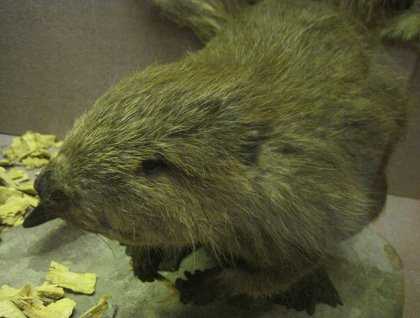What a spectacular day! The morning fog enveloped National Geographic Sea Lion as we entered the great Columbia River estuary at Astoria on the continent’s far western edge. After our morning stretch and hearty breakfast we were off to Fort Clatsop, the site of the winter camp of the Lewis and Clark Expedition in 1805-06. Under clearing skies, National Park Ranger Jill Harding escorted us to the reconstructed fort (just ahead of several eager parties of students from the local Lewis and Clark Elementary School). We toured the fort’s wooded grounds and then explored the nearby interpretive museum. Among the displays was evidence of the commercial purpose of Lewis and Clark: to find a waterway through North America for the purpose of trade in the continent’s most immediately realizable source of wealth, the beaver.
For nearly two hundred years the indispensable headgear for fashionable men in both Europe and America was the beaver hat. Trappers and traders from many nations hauled out beaver pelts for transport to world markets. As Stephen Ambrose reminds us, a cargo of pelts in the early nineteenth century could be sold in St. Louis for $900, then sold again for $9,000 in New York or London, and transshipped and sold again for $90,000 in the lucrative markets of China. No other commodity promised such extraordinary returns as this “soft gold,” the pelts of fur-bearing mammals from the heartland of America.
We were reminded again of this profitable trade as we heard the story of John Jacob Astor, the richest man of his generation who envisioned a global fur-trading empire, exchanging American pelts for the luxury goods of Asia. The Lewis and Clark Expedition laid the groundwork for the bold experiment of Astoria, founded in 1811 as Astor’s intended Pacific Coast depot for the collection of furs for the global market. The perils and profits of this trade were further illustrated as we experienced a hands-on introduction to pelts at the Columbia River Maritime Museum.
In the afternoon, with unseasonable sunshine warming us all, we pursued a variety of options. Some chose to relax on board ship or stroll through the waterfront district of Astoria. Others zoomed out on expedition craft to view lounging California sea lions and a variety of waterfowl. Most of us spent the afternoon pursuing our interest in Lewis and Clark. From the roller-coaster Astoria-Megler Bridge we spied Dismal Nitch (“seriously dangerous” said William Clark) and then planted our feet at Station Camp where the expedition found shelter from raging Pacific storms (unimaginable to us on this day of boundless sunshine and calm seas). We ended the day with spectacular views from Cape Disappointment, imagining ourselves gazing out with those intrepid explorers at “this great Pacific Ocean which we have been so long anxious to see.”







